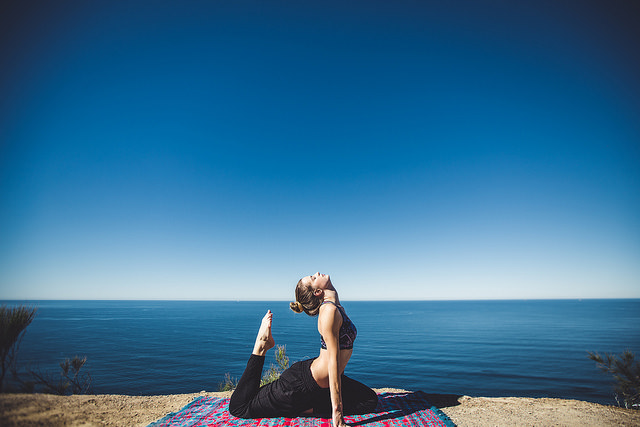Cages are sometimes useful.
A shark cage can enable us to study sharks without being eaten, and a Faraday cage protects us from bolts out of the blue; likewise, our rib cage protects our vital organs.
Unfortunately, over our lifetimes, our rib cages can turn into traps for our emotions, and anytime we feel vulnerable, we herd our feelings into our cages and hide them there, seemingly out of anyone’s view.
I was recently rifling through some old family photo albums, and I happened upon a picture of myself as a young girl. I noticed that not only did I appear to be sinking my heart into my rib cage, but it looked as if my head was in danger of getting sucked into the trap, too. I realise in retrospect that my guarded posture was an act of self-preservation as a result of grief; my father had died just before that image was captured.
Looking with my adult eye through the lens of time, I could understand that the more I imprisoned my feelings, the safer I’d felt, and yet, I wasn’t able to function healthily, either physically or mentally.
Inevitably, my shielded emotions led me into situations and circumstances that left me feeling even more vulnerable and insecure. The frequent trials that I experienced made me increasingly defensive; I was stuck in a vicious circle of self-destruction.
Thankfully, I discovered a form of exercise known as yoga when I was still an adolescent and I followed routines that I’d found in library books. I felt a brief release after each deep stretch and it made me think that stretching and toning was magical—but I was simply giving my heart a temporary reprieve from her long-term hiding place. Any confidence I managed to portray was an act; my heavy heart and thick head would sink back into the ribs at the slightest hint of any unsettling situation.
However, the yoga postures that I adopted weren’t only serving my heart and head with a temporary reprieve from emotional turmoil. The asana also benefited me by releasing my habitual muscular patterns. Without western postural yoga, it was possible that I could one day set an incarcerating physical pattern in place and trap my spirit completely. The simple act of lengthening and toning my body in poses inspired by yoga meant my rib cage was not becoming an inescapable prison.
I carried on giving my heart and head temporary parole for years, but that release would never last long because I only practised sporadically and without any consideration for my breathing. Yoga held my heart softly through all my illnesses and dependencies, but I snatched at yoga with the sole intent of using asana simply to make myself bendier.
It took me a regrettably long time before I found a teacher who transmitted the importance of a dedicated yoga practice. I began to understand that yoga was not just about postures alone, but countless other things too.
I was encouraged to emphasise the quality of the breath in postures, rather than push or pull into ever more elaborate bodily contortions. After a few relapses of interest where I always became ill again, I realised that I needed to have a daily focused practice where I inhaled into back bending poses such as bhujangasana (cobra) and exhaled into forward folds such as uttanasana.
My posture began to improve, and not just temporarily—my permanent stance was held in a way that kept me mentally secure when I noticed my emotional scars smarting.
Realising the importance of the breath in our yoga practice helps us establish a useful, healthy flow of prana (vital energies). The breath is a bridge between the mind and body, and we practice yoga with the aim of making the bridge firm and smooth in any asana practice. Asana can strengthen the foundation of our bridging breath if we inhale into back bends and exhale into forward folds.
Enhancing the quality of the breath in our asana practice enables the prana (intake of new energy) to move unimpeded around the body, and the apana (elimination of old energy) to be released with efficiency. Learning to establish a yoga practice from the vantage of the breath, rather than from the obscured view of our mind’s eye will enable us to appreciate the security of the rib cage when we breathe out. From our securing exhale, we are free to create a completely fulfilling and replenishing inhale.
When our mind nurtures our body via a breath-centred yoga practice, our bodies can gain an ability to heal some of the emotional and mental traumas that impact us from the firing range of our past.
If we practice a breath-centred yoga routine devotedly and sensitively, we can unbind from habitual defensive patterns that are held in our bodies, and in turn, our sometimes tightly-coiled, unpredictable thoughts can unwind to become more benign and less prone to agitate. Breath awareness helps us engage with our outer strength and simultaneously find our calm core.
Breathe in consciously, consciously breathe out—that is the key yoga gives us to unlock the constrictions of a lifetime.
~
Author: Ruth Mielek
Image: Thoroughly Reviewed/Flickr; Marie Aschehoug-Clauteaux/Flickr
Editor: Catherine Monkman
Copy Editor: Nicole Cameron
Social Editor: Taia Butler







Read 0 comments and reply